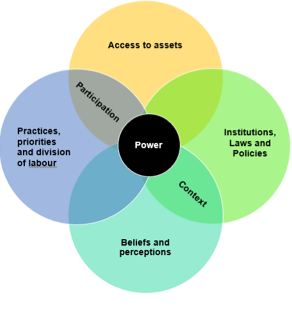Mainstreaming gender equality in Scottish Government funded international development projects and programmes: guidance note
A guidance note on mainstreaming gender equality for applications and bids for Scottish Government funded international development projects and/or programmes. The note outlines our minimum criteria for scoring, aligned with the OECD DAC Gender Equality Policy Marker.
Section 1: Gender Analysis
In line with the OECD DAC Gender Equality Policy Marker guidance, all projects/programmes should be informed by a preliminary gender analysis[7].
What is a gender analysis?
“A gender analysis examines the differences in the roles and responsibilities of people of different genders, daily routines and activities, and access to and control over resources, services and decision-making, including those that lead to social and economic inequalities. It applies this understanding to programme and policy development and to service delivery”. (OECD Gender DAC Marker Handbook)
The purpose of a gender analysis is to better understand the gender equality situation, in order to design projects/programmes that can effectively promote gender equality. It should never be assumed that a proposed project or programme does not have gendered impacts. If a project or programme’s design is not gender sensitive, there is a risk of causing harm, even if unintentional.
Where a project or programme proposal includes a inception/design phase, it is expected that the full gender analysis will be finalised during this phase. The proposed methodology for finalisation of the gender analysis should be detailed in your proposal, then agreed with the SG upon inception.
It is important to note that there is no uniform way of undertaking a gender analysis. Each analysis is context specific and will vary according to the scope of your project or programme. You should use the points below as a guide to ensure your gender analysis is of sufficient quality and scope to shape the design of your project/programme:
1.1 Quality
Disaggerated Data
- Include relevant disaggregated data that is gender-sensitive (considers gender equality) and/or disaggregated by sex. Where possible this should take an intersectional approach – in order to do this, data will also need to be disaggregated by other characteristics, e.g. age group, disability, race, sexual orientation, class, etc.[8][9] In nearly all contexts, good data may be limited so it is important to identify evidence gaps. You should also think about how you can ensure that you are making evidence-based decisions in a way that is practical to the scope of the project.
Analysis
- Evidence with citations and references: This must be balanced with perspectives from a diverse range of people. Ideally, this should be done in a participatory way including those with lived experience of the issues your intervention is trying to address. This may be expanded upon in inception phase.
Perspectives
- Use gender expertise where relevant: Gender analysis requires experts by profession and/or experience, as well as relevant stakeholders.[10] Gender equality expertise is crucial for the successful achievement of gender equality outcomes.[11] To be effective, gender equality advisors need to be integral proactive members of the project team, who are involved early in the planning stage and consistently throughout the initiative.[12]
1.2. Scope
- Be relevant to the focus of the project: Your gender analysis should focus on the specific challenge or problem that your project is trying to address and should be an integral part of your problem identification and needs analysis.[13]
- Understand the issues and context: Your gender analysis should consider the cultural, institutional, and political context in which the project is taking place.[14] This will help to identify the specific gender-related issues and barriers that need to be addressed. Active involvement and participation of relevant stakeholders including those with lived experience of the issues your intervention is trying to address is one of the best ways to ensure that the contextualised analysis is based on the “local realities and linked to the goals, needs and priorities”.[15]
- Examine both gender roles and gender relations: A gender analysis framework can provide a useful structure.[16] You may find it useful to consider:
Access to assets
This considers the resources that people have access to, such e.g. tangible (land, capital, tools) or intangible (knowledge, education, and information).[17] These assets can help people to be productive members of their communities and to improve their lives.
Practices, priorities and division of labour [18]
This looks at the way that tasks and responsibilities are allocated across genders - the actual activities that people do in their daily lives. It is also what different genders value and see as important.
Institutions, laws and policies [19]
This could look at how institutions, laws and policies affect genders differently. This includes things like government, the legal, and education system. It could also consider formal and informal rights.
Beliefs and perceptions[20]
This could explore cultural values and norms of the society your project is operating in and how they facilitate or limit access to education, services, and economic opportunities.

- You should also consider institutional capacity.[21][22] This includes an analysis of the capacity of the institutions/organisations responsible for project implementation (or that will influence the achievement of results) to work with a gender equality perspective and achieve gender equality results. This may include identification of capacity gaps within individual and organisational assets and approaches to gender equality and women’s empowerment to inform capacity strengthening interventions. [23]
Contact
Email: ceu@gov.scot
There is a problem
Thanks for your feedback